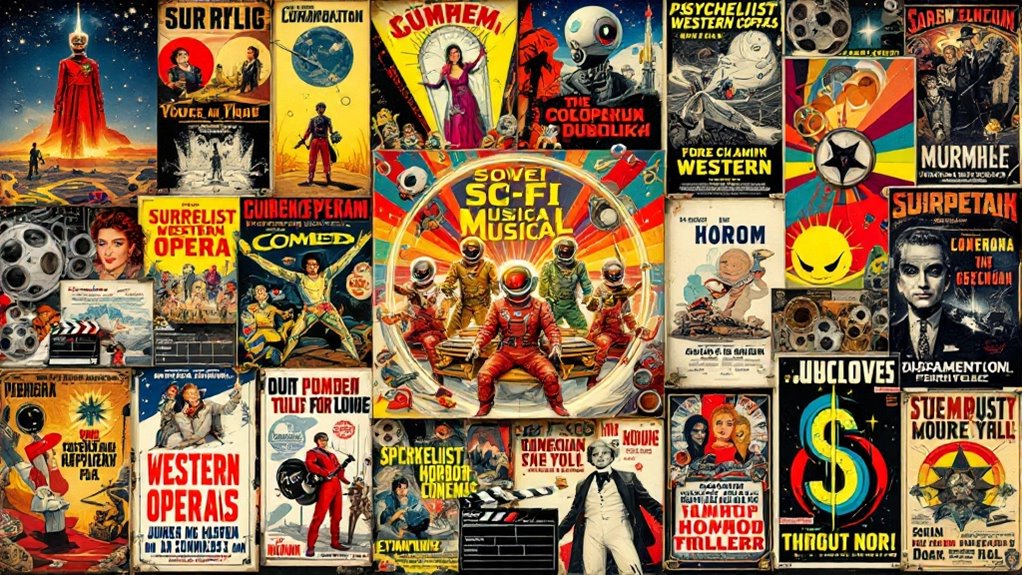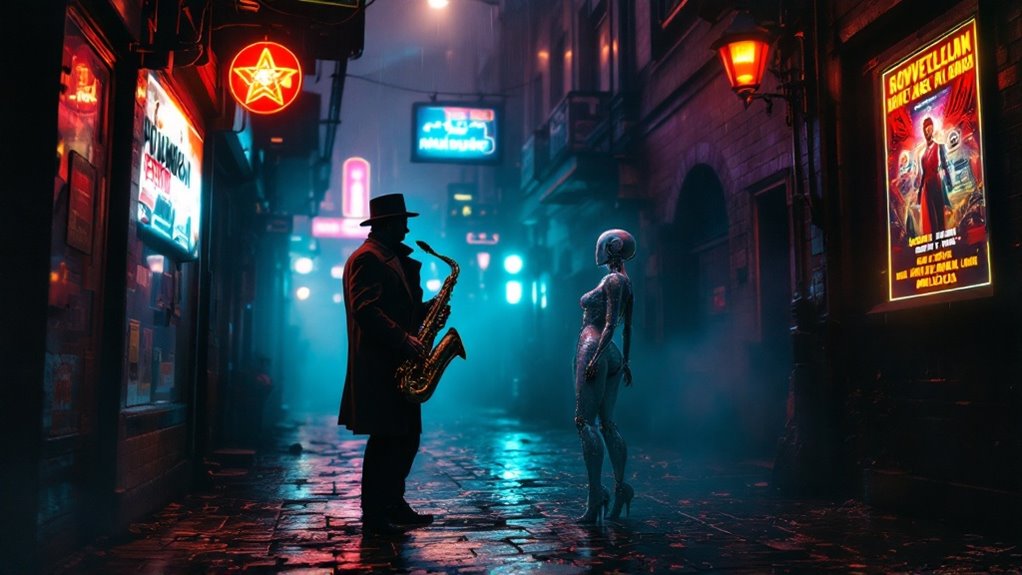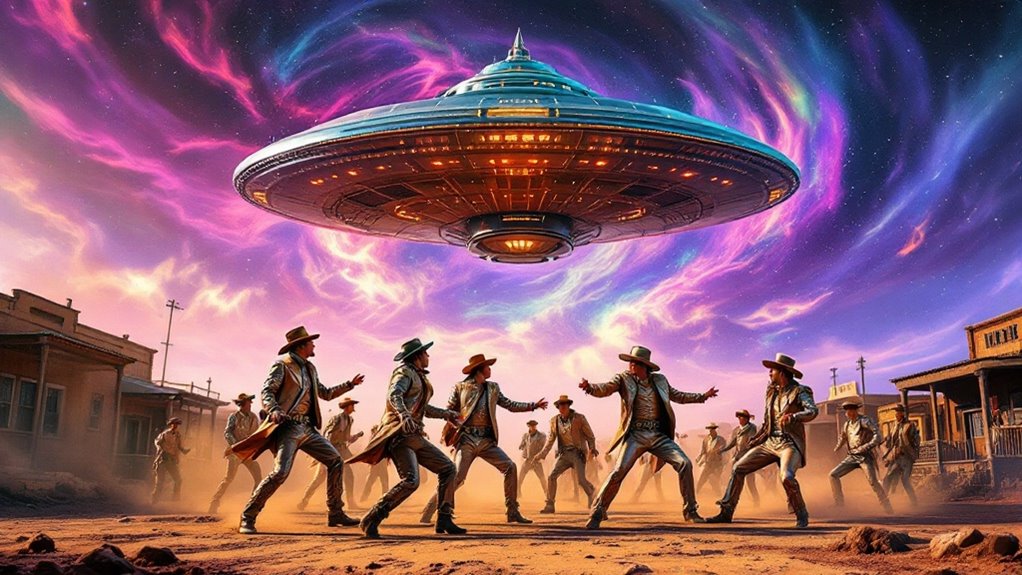It’s curious how you stumbled upon this peculiar topic, just as the strange world of Soviet Sci-Fi Musicals might catch you off guard. These rare genres, like the intriguing Aelita: Queen of Mars, blend unexpected elements that challenge conventional storytelling. Out of the dark humor of Necrorealism to the surreal narratives of Bizarro Films, each genre offers a unique cinematic experience. Ever wondered what a Sea Life Sports movie entails or how Ostern movies reinterpret the classic Western? There’s a lot more to these genres than meets the eye, and the surprises don’t stop there.
Soviet Sci-Fi Musicals
Soviet sci-fi musicals are a fascinating blend of creativity and ideology, born out of the early 20th-century socialist and constructivist movements. Envision a world where catchy tunes and futuristic visions collide, painting a picture of Soviet aesthetics that’s both bold and intriguing.
These films, with musical propaganda at their core, were more than just entertainment; they were a reflection of the era’s cultural exploration and historical context. Valentin Kruchinin, recognized as an Honoured Artist of RSFSR in 1964, was pivotal in shaping the musical landscape of Soviet sci-fi with his innovative compositions. Take Aelita: Queen of Mars (1924), for instance. Even though it’s a silent film, it set the stage for Soviet sci-fi, blending Valentin Kruchinin’s musical accompaniment with its ambitious storyline.
As you delve deeper into this genre, you’ll notice the sci-fi influence isn’t limited to space travel and cosmic adventures. Instead, it extends to the music itself. By the 1960s, films like Amphibian Man introduced electronic music, adding a futuristic flair to the Soviet cinema landscape.
The government didn’t just approve of these films; they championed them, seeing them as a vehicle for promoting socialist ideals. So, if you’re curious about this unique genre, you’re in for a ride that’s as educational as it is entertaining.
Necrorealism
Necrorealism, a genre marked by its macabre absurdity, emerged out of the shadows of late-Soviet Russia as a stark counterpoint to Socialist realism. You’ll find it teeming with dark humor and absurd imagery, pushing boundaries with themes of death, decay, and body transformation.
This genre’s unorthodox style often leaves viewers both perplexed and amused, as it highlights the absurdity of life through a lens of black comedy. Yevgeny Yufit, the father of Necrorealism, led this unique cinematic rebellion. His film Lesorub (The Woodcutter, 1985)_ offers a symphony of distorted music and silent, incoherent dialogue, setting the tone for a genre that thrives on shock.
Another notable film, Vesna (Spring, 1987)_, features bizarre scenes like a tug of war with a rope threaded through a man’s body. These films challenge audiences, using disquieting imagery to detach them from traditional narratives. Necrorealism didn’t just pop out of nowhere; it sprouted from the socio-political chaos of 1980s Russia.
As part of the Parallel Cinema movement, it offered a darkly satirical escape from the official Soviet Goskino State Cinema. This movement intersects with other art movements of the late 20th century, engaging with philosophical questions about existence and death. So, if you’re in the mood for something genuinely offbeat, Necrorealism might just be your cinematic adventure.
Bizarro Films

Out of the shadowy alleys of Necrorealism’s dark humor and absurdity springs another peculiar genre: Bizarro films. Envision stumbling into a world where surreal narratives and grotesque humor blend seamlessly, leaving you both puzzled and fascinated.
These films, born from a literary genre, push boundaries with their absurd and surreal content. They’re too weird to be merely cult films, and their origins trace back to literary publishers like Eraserhead Press, echoing the enigmatic style of David Lynch. Bizarro films captivate with their unconventional narrative structures and visuals.
David Lynch’s Eraserhead offers a seminal experience, pulling you into a nightmarish landscape that challenges your perception of reality. Alejandro Jodorowsky’s Holy Mountain and El Topo blur the lines between spiritual quest and psychedelic trip, serving up thought-provoking themes wrapped in surreal imagery. Meanwhile, Tetsuo: The Iron Man takes you on a visceral journey through the grotesque, merging human and machine in a disturbing yet intriguing dance.
While Bizarro films attract a niche audience, their impact is undeniable. They inspire filmmakers to explore the surreal and absurd, leaving an indelible mark on avant-garde cinema and inviting you to welcome the beautifully bizarre. The genre’s surreal, grotesque nature sets it apart, challenging conventional storytelling and pushing audiences to embrace the unexpected.
Sea Life Sports
Emerging out of the lively shores of Japan is a film genre as fascinating as it is bizarre: Sea Life Sports. Envision watching a wrestling match where the competitor suddenly transforms into a giant squid. That’s the essence of The Calamari Wrestler (2004), a surreal narrative that brings sports transformations to life in the quirkiest way possible.
This genre thrives on blending elements of sea life with the competitive spirit of sports, creating stories that are both absurd and thought-provoking. Movie genres are important because they categorize films based on content and style, aiding viewers in discovering new films and enriching discussions on film history and theory. In these films, you’ll find a world where fantasy meets reality, where a transformation due to illness or some mysterious cause can lead to unusual advantages in sports.
Crust (2003) is another enigmatic example, though details are as elusive as a shadow in the sea. The humor and bizarre scenarios make these films more than just stories—they’re experiences. You might find yourself laughing at the absurdity or pondering deeper meanings behind the transformations. Whether it’s a giant squid in the ring or another sea creature taking center stage, these films invite you to explore narratives that are as surreal as they are engaging.
Neo Noir

Drenched in shadows and neon glow, Neo Noir captivates with its intoxicating blend of style and substance. You’re drawn into a world where visual aesthetics steal the show, using high-contrast lighting and neon hues to cast an unforgettable moody ambiance. Envision watching scenes bathed in saturated colors, with slanted shadows creeping across the screen, creating a tension you can almost feel. It’s like stepping into a dream where every detail is designed to unsettle and intrigue.
In Neo Noir, moral ambiguity reigns supreme. Characters navigate a labyrinth of crime, corruption, and personal demons, leaving you questioning what’s right or wrong. Stories unfold with complex, non-linear narratives, keeping you guessing. You might find yourself empathizing with anti-heroes, flawed yet fascinating, as they grapple with existential dread or chase after femme fatales who are as dangerous as they are alluring.
Drawing from classic noir, Neo Noir updates its themes for today’s audience, influenced by directors like Martin Scorsese and Quentin Tarantino. Films like Chinatown and Blade Runner showcase this genre’s mesmerizing allure. The genre emerged in the late 1950s, transitioning from the classic noir era due to societal changes and advancements in filmmaking technology. So, next time you’re in the mood for a film that challenges your perceptions, immerse yourself in the shadowy depths of Neo Noir.
Body Horror
While Neo Noir captivates with its shadowy allure, Body Horror grips you with its visceral, unsettling nature. Conceive the unease of witnessing graphic transformations, where the human body becomes a canvas for terror and existential fear. This genre explores the grotesque, often featuring disturbing mutilations and unnatural movements that push the limits of what’s acceptable in mainstream cinema.
Films like The Exorcist shock with scenes like a 360-degree head twist, while SAW traps its characters in gruesome scenarios that challenge both the mind and the flesh. Body Horror is an exploration of existential terror, highlighting the fragility of human life.
It often critiques societal norms by symbolizing death and decay through the deterioration of the human body. Filmmakers use genre conventions to critique or explore cultural narratives, adding a layer of depth to the unsettling visuals. Medical horror adds another layer, feeding our fears of invasive procedures or the unknown within the medical profession.
This genre’s psychological impact is profound, as characters face mental anguish due to these bodily changes. With its cult following and evolving influence, Body Horror crosses into other genres, using new technologies to create more realistic and creepy effects. It’s not for the faint-hearted, but it’s undeniably fascinating.
Ostern Movies

Ostern movies, a fascinating film genre born in the Soviet Union, offer a unique twist on the classic Western. Imagine this: vast steppes instead of dusty deserts, stoic heroes on horseback, and tales set against the backdrop of the Russian Revolution.
Emerging during the Khrushchev Thaw of the 1960s, Osterns were a creative response to the American Westerns that had captivated audiences worldwide. The genre’s name cleverly combines the German word “Ost” (East) with “western,” hinting at its origin and intent.
Ostern characteristics include sweeping shots of endless skies, rugged landscapes, and lone protagonists traversing the tumult of history. Unlike their American counterparts, Osterns often carried distinct ideological messages. Films like The Elusive Avengers and White Sun of the Desert exemplify Ostern characteristics, blending adventure with Soviet themes. Some argue that Stalin sought to integrate the Western genre into Soviet cinema, further shaping this unique genre.
The Ostern legacy is evident today, influencing modern films in Eastern Europe and beyond. With their unique blend of history and cinematic flair, Osterns challenge and entertain, offering a fresh perspective on the Western genre.
Wrapping up
You’ve just taken a whirlwind tour through the galaxy of bizarre cinema genres, each more mind-bending than the last. Who knew movies could be as outlandishly diverse as a unicorn in a field of horses? From Soviet Sci-Fi Musicals to Ostern films, these genres defy convention and invite you to expand your cinematic horizons. So, next time you’re in the mood for something extraordinary, immerse yourself in these unique films and let your imagination run wild!




